 |
||||
Harmful Algal Blooms in Lake Erie - HAB Bulletin
Background
Microcystis and Microcystin
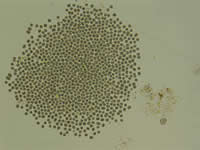 The recent increases in cyanobacterial HABs in the Great Lakes has caused significant concern for human and
ecosystem health due to the production of toxins by bloom species. In the Great Lakes, Microcystis often
forms dense blooms that can discolor the water, cause taste and odor issues in drinking water and affect public
health and the health of wildlife, livestock and domestic animals through their potential to produce the
hepatotoxin microcystin (Brittain et al. 2000, Carmichael 1994, 1997, Vanderploeg et al. 2001). Preliminary studies
have documented the presence of microcystins in the Great Lakes, at times exceeding the recommended limit of
1 µg L-1 of microcystin established by the World Health Organization for drinking water supplies
(Brittain et al. 2000, Vanderploeg et al. 2001). The increase in large Microcystis blooms in recent
years has caused considerable concern due to the dependence on these waters as a resource and the health
risks attributable to microcystins. Local sampling has verified the bloom, and water treatment managers have
also reported foul odor and taste in local waters.
The recent increases in cyanobacterial HABs in the Great Lakes has caused significant concern for human and
ecosystem health due to the production of toxins by bloom species. In the Great Lakes, Microcystis often
forms dense blooms that can discolor the water, cause taste and odor issues in drinking water and affect public
health and the health of wildlife, livestock and domestic animals through their potential to produce the
hepatotoxin microcystin (Brittain et al. 2000, Carmichael 1994, 1997, Vanderploeg et al. 2001). Preliminary studies
have documented the presence of microcystins in the Great Lakes, at times exceeding the recommended limit of
1 µg L-1 of microcystin established by the World Health Organization for drinking water supplies
(Brittain et al. 2000, Vanderploeg et al. 2001). The increase in large Microcystis blooms in recent
years has caused considerable concern due to the dependence on these waters as a resource and the health
risks attributable to microcystins. Local sampling has verified the bloom, and water treatment managers have
also reported foul odor and taste in local waters.
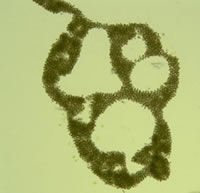 There
have been multiple cases of gastrointestinal distress, skin
irritation and nausea as a result of recreational exposure
to microcystins. Recent reports (Backer et al. 2008) have
indicated that microcystins can be aerosolized, making recreational
activities such as boating and jet-skiing a higher risk of
exposure. Microcystins may act as tumor promoters and there
is increasing evidence that these compounds may be more harmful
through long term chronic exposure, such as low doses in drinking
water, rather than short term acute exposure (Carmichael 1997).
This chronic toxicity is of significant concern to communities
that are consuming drinking water with cyanotoxins in small
doses over a lifetime.
There
have been multiple cases of gastrointestinal distress, skin
irritation and nausea as a result of recreational exposure
to microcystins. Recent reports (Backer et al. 2008) have
indicated that microcystins can be aerosolized, making recreational
activities such as boating and jet-skiing a higher risk of
exposure. Microcystins may act as tumor promoters and there
is increasing evidence that these compounds may be more harmful
through long term chronic exposure, such as low doses in drinking
water, rather than short term acute exposure (Carmichael 1997).
This chronic toxicity is of significant concern to communities
that are consuming drinking water with cyanotoxins in small
doses over a lifetime.
+ Microcystin concentrations for Western Lake Erie
+ Toledo Channel Marker #2 Webcam
Experimental HAB Bulletin
An experimental HAB bulletin has been developed to provide a weekly forecast for Microcystis blooms in western Lake Erie to local health officials, water treatment managers, natural resource managers and several research scientists in the area. The bulletin is the first Harmful Algal Bloom Bulletin issued in the Great Lakes and the second in the Nation and is a result of cooperation between researchers at NOAA Center for Coastal Monitoring and Assessment (NOS) and the NOAA Great Lakes Environmental Research Laboratory (OAR), with data from the NOAA CoastWatch Program, the Great Lakes Operational Forecast System and the National Buoy Data Center. Funding is provided by the Great Lakes Center of Excellence in Oceans and Human Health and the Centers for Disease Control. This experimental forecast is not yet a component of NOAA’s Operational HAB forecast system.
Using MERIS satellite imagery (distributed by NOAA’s National Environmental Satellite, Data, and Information Service Coastwatch program), Wynne et al. (2008) has documented that surface reflectance at 681nm may be a useful indicator of Microcystis concentrations in the Great Lakes and the NOAA-NOS team (R. Stumpf lead) has developed an algorithm for determining cyanobacterial cell concentrations from surface reflectance. Data from the MERIS imagery was then used as input data into a Lagrangian particle tracking model with 2D horizontal transport that also allows for wind-induced movement of cells. This model was incorporated with the Great Lakes Forecast System developed by D. Schwab (GLERL), D. Beletsky (CILER) and colleagues. Satellite imagery is monitored on a weekly basis and when there are significant cyanobacterial blooms present, their location and approximate densities are input into this tracking model in order to predict the movement of the bloom. In order to test the accuracy of these predictions, small boats are used to sample transects across the regions where the blooms were first detected by satellite imagery and where they were predicted to be transported to. Microcystis cell counts are also included in the HAB bulletin, in addition to a summary and analysis of the forecasted bloom.
Images of Microcystis in Western Lake Erie taken Summer 2009
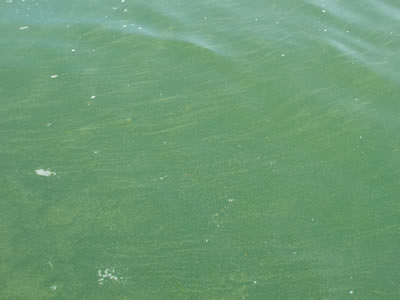
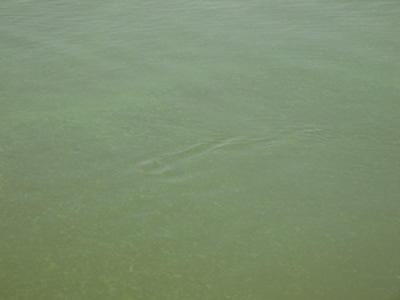
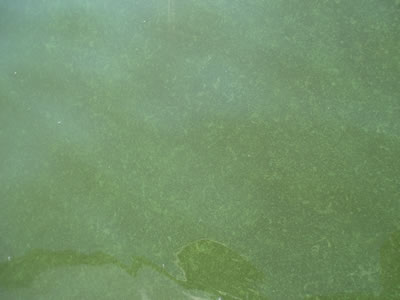
Cited References
Backer, L.C., W. Carmichael, B. Kirkpatrick, C. Williams, M. Irvin, Y. Zhou, T.B. Johnson, K, Nierenberg, V.R. Hill, S.M. Kieszak, and Y.S. Cheng. 2008. Recreational exposure to low concentrations of microcystins during an algal bloom in a small lake. Mar. Drugs 6:389-406.
Brittain, S.M., Wang, J., Babcock-Jackson, L., Carmichael, W.W., Rinehart, K.L.and Culver, D.A., 2000. Isolation and characterization of microcystins, cyclic heptapeptide hepatotoxins from a Lake Erie strain of Microcystis aeruginosa. J. Great Lakes Res. 26: 241-249.
Carmichael, W.W., 1994. The toxins of cyanobacteria. Sci. Am. 270: 78-86.
Carmichael, W.W., 1997. The cyanotoxins. Advances in Botanical Research 27: 211-240.
Vanderploeg, H.A., Liebig, J.R., Carmichael, W.W., Agy, M.A., Johengen, T.H., Fahnenstiel, G.L.and Nalepa, T.F., 2001. Zebra mussel (Dreissena polymorpha) selective filtration promoted toxic Microcystis blooms in Saginaw Bay (Lake Huron) and Lake Erie. Canadian Journal of Fisheries and Aquatic Sciences 58: 1208-1221.
Wynne, T., R. Stumpf, M. C. Tomlinson, R. A. Warner, P. A. Tester, J. Dyble, and G. Fahnenstiel. 2008. Relating spectral shape to cyanobacteria blooms in the Laurentian Great Lakes. Int. J. Remote Sensing. 29:3665-3672.
For more information, please contact:
Juli Dyble Bressie or, Michelle Tomlinson ()

